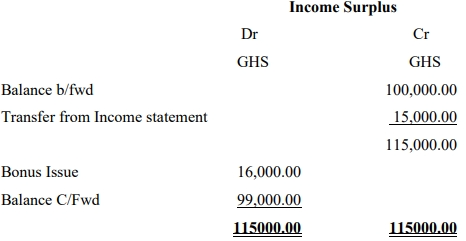- 6 Marks
Question
Talensi, a company reporting under IFRS, is considering making the following changes to its financial statements for the year ended 31 December 2017. Talensi presents one year of comparative information.
- Changing the method of depreciation of its plant from straight-line depreciation over five years (with a nil residual value) to reducing balance at 20% per annum with effect from 1 January 2017. The plant originally cost GH¢100 million on 1 January 2015.
- Changing the basis of valuation of certain non-seasonal inventories from first-in, first-out (FIFO) to weighted average cost (WAC). Inventories were valued as follows under the two different methods:
31 December 2015 31 December 2016 31 December 2017 FIFO: GH¢64 million FIFO: GH¢66 million FIFO: GH¢71 million WAC: GH¢62 million WAC: GH¢63 million WAC: GH¢67 million - Changing the revenue recognition basis for certain seasonal goods that were first sold in 2015 such that revenue is recognised on delivery to the customer rather than on shipment. This has arisen as a result of a change in delivery arrangements such that, with effect from 1 January 2017, risks are now borne by Talensi until delivery has been made to the customer.
2015 2016 2017 Revenue based on shipment date: GH¢50 million GH¢86 million GH¢90 million Revenue based on delivery date: GH¢46 million GH¢84 million GH¢88 million
The cost of the seasonal goods is consistently 80% of sales price.
Profit (calculated using existing policies and accounting estimates) was GH¢240 million for the year ended 31 December 2017.
Required:
Calculate the adjustment to opening retained earnings in the statement of changes in equity (including 2016 comparative figures) in the financial statements for the year ended 31 December 2017 and profit or loss for the year ended 31 December 2017.
Answer
Opening retained earnings
| GH¢ million | GH¢ million |
|---|---|
| Profit using existing policies | – |
- Depreciation method (change in estimate):
- Old depreciation: 100/5 years = GH¢20 million
- Revised depreciation (GH¢100 million x 3/5) x 20% = GH¢12 million
- Inventory valuation (change in policy):
- Adjustment to opening inventories (62 – 64) / (63 – 66) = GH¢(2 million) = GH¢3 million
- Adjustment to closing inventories (67 – 71) = GH¢(4 million)
- Revenue recognition (change in nature, not policy):
- Apply from 1 January 2017 (88 – 90) x 20% = GH¢(0.4 million)
| | GH¢(2 million) | GH¢246.6 million |
(15 ticks @ 0.4 marks = 6 marks)
- Topic: Financial Reporting Standards and Their Applications
- Series: NOV 2018
- Uploader: Dotse

